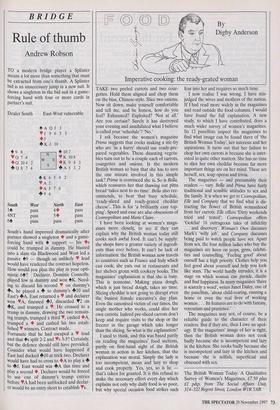BRIDGE
Rule of thumb
Andrew Robson
TO a modern bridge player a Splinter means a lot more than something that must be extracted from one's thumb. A Splinter bid is an unnecessary jump in a new suit. It shows a singleton in the bid suit in a game- forcing hand with four or more cards in partner's suit.
Dealer South 49 8
♦ Q 7 4 ♦ Q 104 2 Q 8 7 4
4 South West 14 pass 4NT pass 64 pass East-West 4A QJ V.11. 9 6
♦ 5 4.K J 10
vulnerable
3 5 3
4 10 7 VK 108
♦ K 9 8 3 • A 5 3 2 4 2 6
East pass pass pass North 4♦ 5♦ pass
N
w E
S
K 6 5
♦ A 2 ♦ A J 7 +9 6
South's hand improved dramatically after partner showed a singleton ♦ and a game- forcing hand with 4 support — his ♦s could be trumped in dummy. He blasted Into a slam via Blackwood and West led a passive 49 — though an unlikely V lead would have rendered the contract hopeless. How would you plan the play in your opti- mistic 64? Declarer, Dominic Connolly, played low in dummy and won 4K. Need- ing to discard his second V on dummy's 4s, he played a + to dummy's +10 and East's +A. East returned a V and declarer won VA, finessed +1, discarded V2 on 4K, and trumped a V. He crossed to a trump in dummy, drawing the two remain- ing trumps, trumped a third V, cashed 4A, trumped a ♦ and cashed his two estab- lished V winners. Contract made.
Fortunate that he had escaped a V lead and that 4s split 2-2 and Vs 3-3? Certainly, but the defence should still have prevailed. Consider what would have happened if East had ducked 410 at trick two. Declarer would have had to cross to ♦A to play a + to 4.1. East would win +A this time and play a second ♦. Declarer would be forced to use one of dummy's trump entries before VA had been unblocked and declar- er would be an entry short to establish Vs.


















































































 Previous page
Previous page